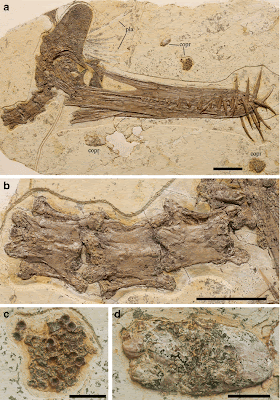Guidraco venator
Wang, Kellner, Jiang & Cheng 2012
Abstract
Despite the great increase in pterosaur diversity in the last decades, particularly due to discoveries made in western Liaoning (China), very little is known regarding pterosaur biogeography. Here, we present the description of a new pterosaur from the Jiufotang Formation that adds significantly to our knowledge of pterosaur distribution and enhances the diversity of cranial anatomy found in those volant creatures. Guidraco venator gen. et sp. nov. has an unusual upward-directed frontal crest and large rostral teeth, some of which surpass the margins of the skull and lower jaw when occluded. The new species is closely related to a rare taxon from the Brazilian Crato Formation, posing an interesting paleobiogeographic problem and supporting the hypothesis that at least some early Cretaceous pterosaur clades, such as the Tapejaridae and the Anhangueridae, might have originated in Asia. The association of the new specimen with coprolites and the cranial morphology suggest that G. venator preyed on fish.
Keywords: Pterosauria, Guidraco, Jiufotang Formation, Early Cretaceous, China
Pterosauria Kaup 1834
Pterodactyloidea Plieninger 1901
Pteranodontoidea Marsh 1876, sensu Kellner 1996, 2003
Guidraco venator gen. et sp. nov.
Etymology: Gui, malevolent ghost in Chinese culture combined with draco, from Latin meaning dragon; venator, the Latin word for hunter.
Fig. 1 Guidraco venator gen. et sp. nov., holotype (IVPP V17083),
from the Jiufotang Formation (Early Cretaceous) of western Liaoning, China: a complete specimen, b cervical vertebrae, and c and d coprolites. copr Coprolite, pla plant. Scale bars 5,3,1,1 mm
Fig. 2 Guidraco venator gen. et sp. nov., holotype (IVPP V17083),
a line drawing of the specimen and b reconstruction of the skull.
Fig.3 Reconstruction of Guidraco venator (Image by Maurilio Oliveira)
Xiaolin Wang, Alexander W. A. Kellner, Shunxing Jiang and Xin Cheng. 2012. New toothed flying reptile from Asia: close similarities between early Cretaceous pterosaur faunas from China and Brazil. Naturwissenschaften. 99. doi: http://dx.doi.org/10.1007/s00114-012-0889-1
Guidraco venator: 120-Million-Year-Old 'Ghost Dragon' Pterosaur Discovered in China http://www.wired.com/wiredscience/2012/02/guidraco-flying-dinosaur/






